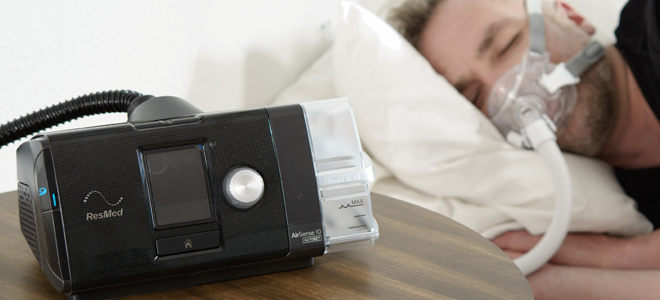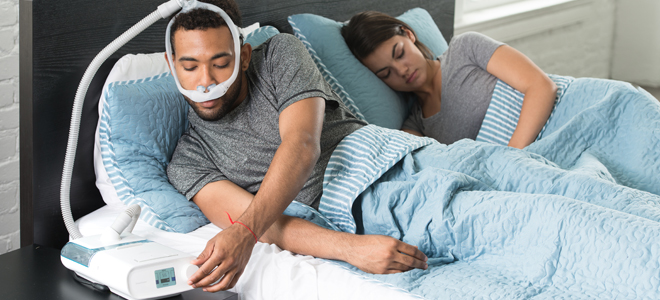
While summer heralds the days of swim shorts and sun tan lotion, the mere mention of winter heralds less desirable things, like bulky sweaters, closed highways, slipping on the sidewalk, staying inside and, of course, the dreaded flu or cold. Indeed, the warm days will be behind us soon, which means that it is nearly time to pop that thermometer in your mouth and make some soup, because it’s almost flu season. While seasonal colds and flus can be semi-manageable, albeit very uncomfortable, for those suffering from sleep apnea, it can be close to unbearable. On top of having to wear a CPAP mask, you may also have a stuffy nose, sore throat, cough or nasal congestion to contend with, which can make adhering to treatment seem like a Sisyphean feat. You may even want to take a break from treatment – at least until you are all cleared up – but doctors will tell you that it is imperative that you don’t. It is even more critical to adhere to CPAP treatment when you are under the weather, because your body will rely on deeper, more restorative sleep to feel better. So, your option is to either suspend treatment and risk getting sicker, or find some different options so that you can wear your CPAP mask more comfortably. Here are five tips on how to stick to CPAP treatments when you have a cold or flu.
1. Use a full face mask opposed to a nasal mask.
Sometimes we just have to ride the wave of a flu or cold until it leaves our system, so you may be dealing with a moderate to severe runny nose and some nasal congestion for a couple of weeks. There are a lot of downsides to this, but one of the biggest downsides is that your nose will pretty much be out of service–leaving your mouth to do most of the breathing. If this is the case, you may want to ask your physician to write you a prescription for a full face CPAP mask. This way you can still benefit from the restorative powers of CPAP treatment while you wait for your seasonal cold to go away and for your nose to come back in service. Having a full face mask as a backup is ideal, just in case you suddenly catch something. The most minimal full face masks on the market are the Amara View or the DreamWear Full Face, perfect substitutes for those who usually use smaller nasal masks.
2. Try an auto-titrating CPAP machine.
When it comes to CPAP machines, you have the traditional model, which provides a singular flow of therapeutic pressure through the respiratory system, and then you have the auto-titrating CPAP machine, which uses unique, high-tech algorithms to provide pressure at automatically regulated levels. Basically, with auto CPAP machine, you don’t have to do anything but sleep – the machine will read how hard or normal you are breathing and will decrease or increase the pressure accordingly. For sleep apnea sufferers that are more prone to seasonal flu or allergy symptoms, you may benefit from an automatic CPAP machine, because it could allow you to receive treatment more comfortably. Doctors say that if you plan on having a few eggnogs this holiday season, that you might want to further investigate the benefits of an auto CPAP machine. Our best-selling auto CPAPs are the AirSense 10 Auto and DreamStation Auto, which both deliver high quality sleep even when you are feeling under the weather.
3. Use a heated humidifier.
When you have a winter cold, flu or a sinus infection, it can make regular breathing difficult, so you can imagine how hard it would be trying to sleep without your CPAP. If you could take a closer look at your nasal passages during a winter cold, it wouldn’t look so pretty. First of all, you have swollen mucous membranes, dryness, and lots of phlegm building up. Second of all, you have a whole host of other biological responses that your body is using to fight whatever virus you may have. When it comes to dryness, using a heated humidifier can restore moisture levels in your nasal passages, so that you can drift off to sleep easier and hopefully wake up feeling more refreshed.
4. Try changing your sleeping position.
Are you a back sleeper? If you have nasal congestion or a runny nose, sleeping on your back can make it much more uncomfortable to sleep and receive CPAP therapy. In this case, it is recommended to sleep with a few pillows under your neck so that you can have a bit of leverage and elevation. The key is to not let that post nasal drip cause an increase of mucous to build up. If you can force yourself to, you may be more comfortable sleeping on your side. Everyone knows how hard it can be to switch sleeping positions, but doing so could mean the difference between getting a good night’s sleep and not getting any rest at all.

5. Decongestants and other over the counter nasal sprays.
If your nose is particularly runny or congested, it can make sleeping with a CPAP mask like trying to breathe underwater. Of course, a runny nose is perhaps one of the worst symptoms of seasonal flu, and even seasonal allergies, because it never seems to stop. Where does all that snot come from? If this is the case, you might want to head to your pharmacy and look for an over the counter nasal spray that is specifically designed to clear the congestion caused by the common cold. If it is allergies that are causing your runny nose and congestion, you may want to look for an antihistamine nasal spray. Make sure, though, to read the directions thoroughly. Also, try not to spray anything in your nose that has sedating agents – those can be bad for you. If you can’t conquer the congestion with over the counter sprays, you may want to speak with your physician, because you may need the heavier duty stuff.















